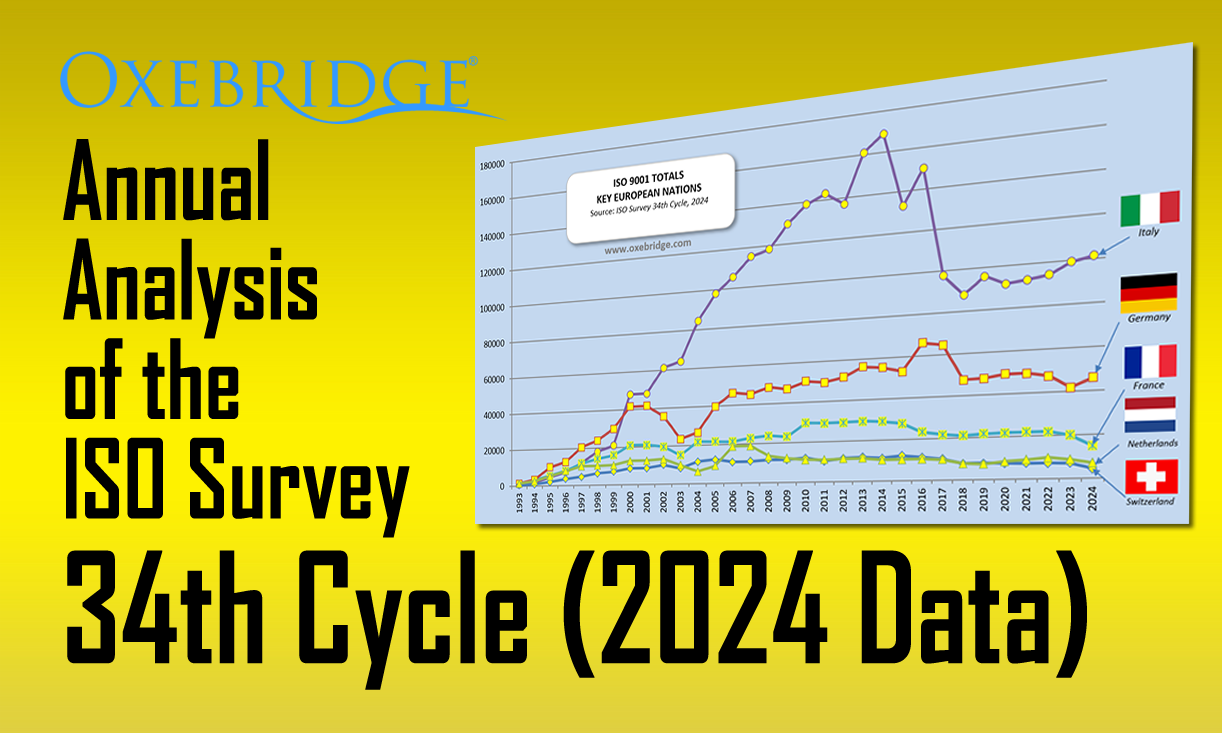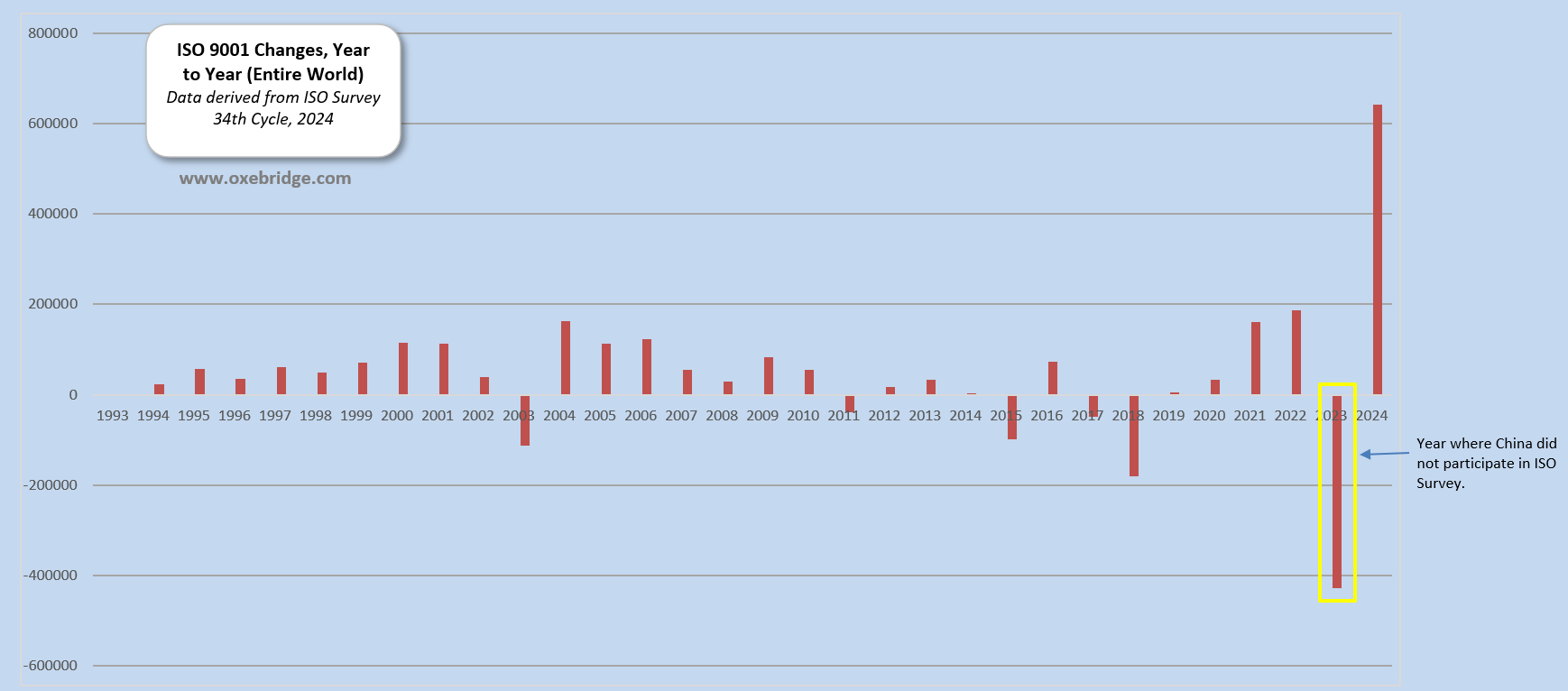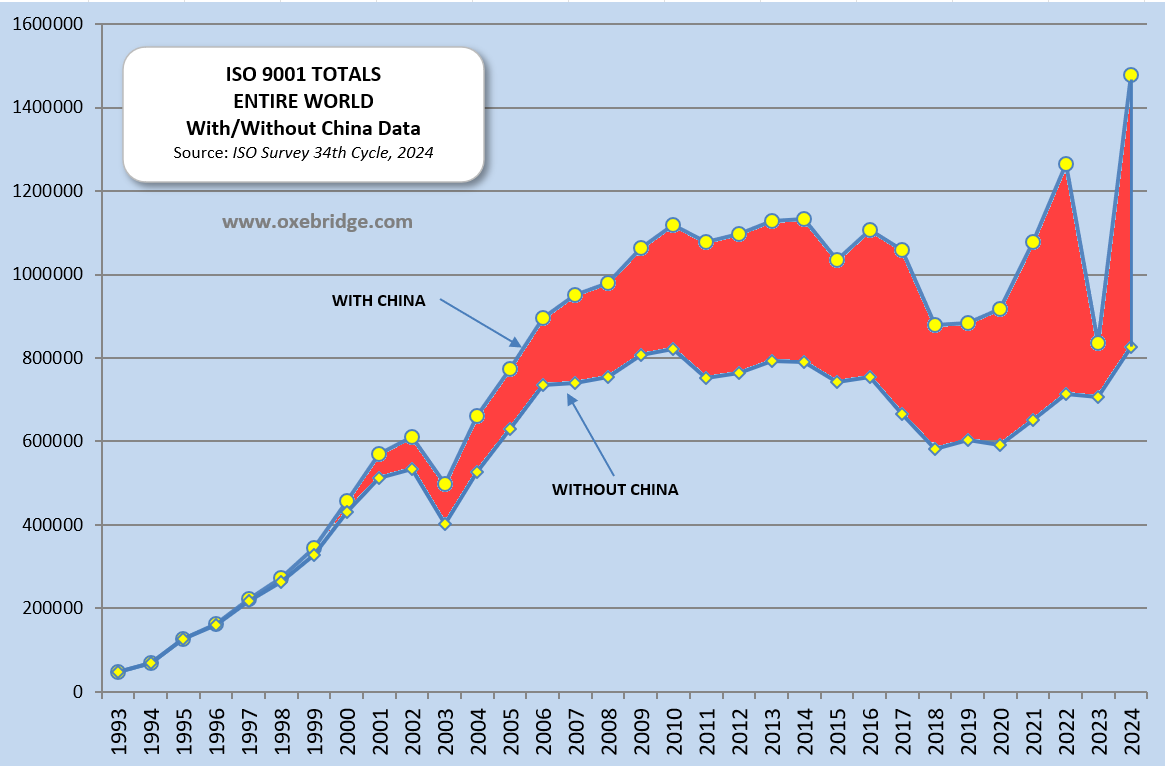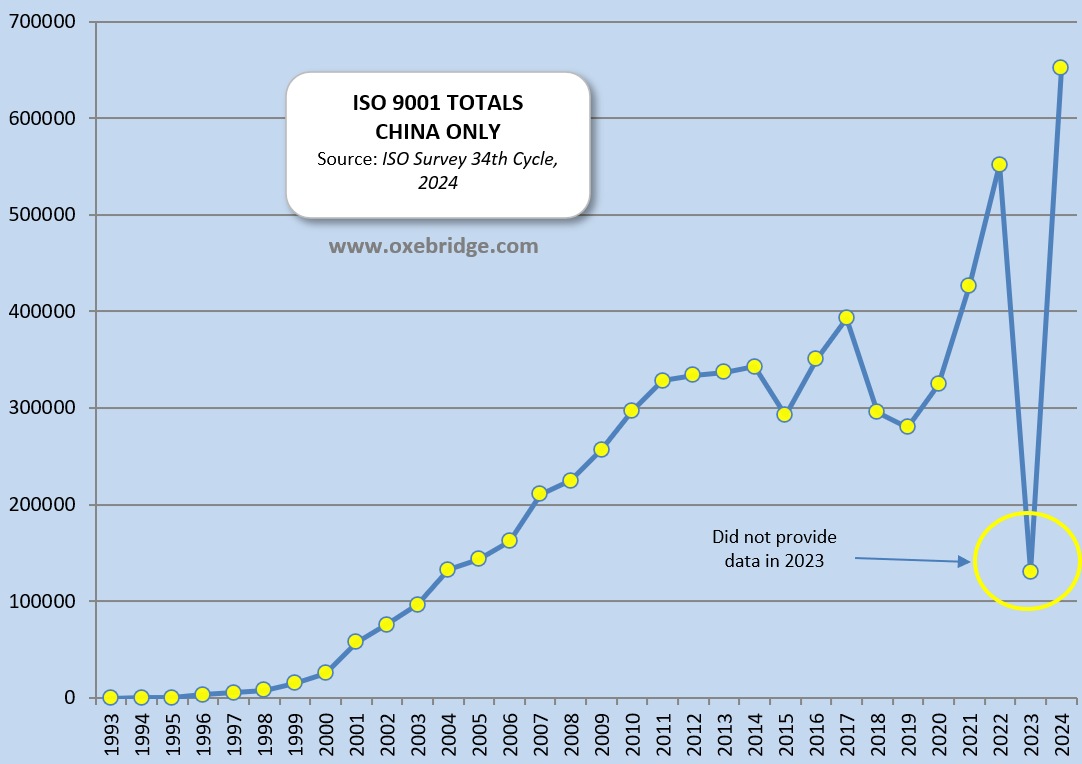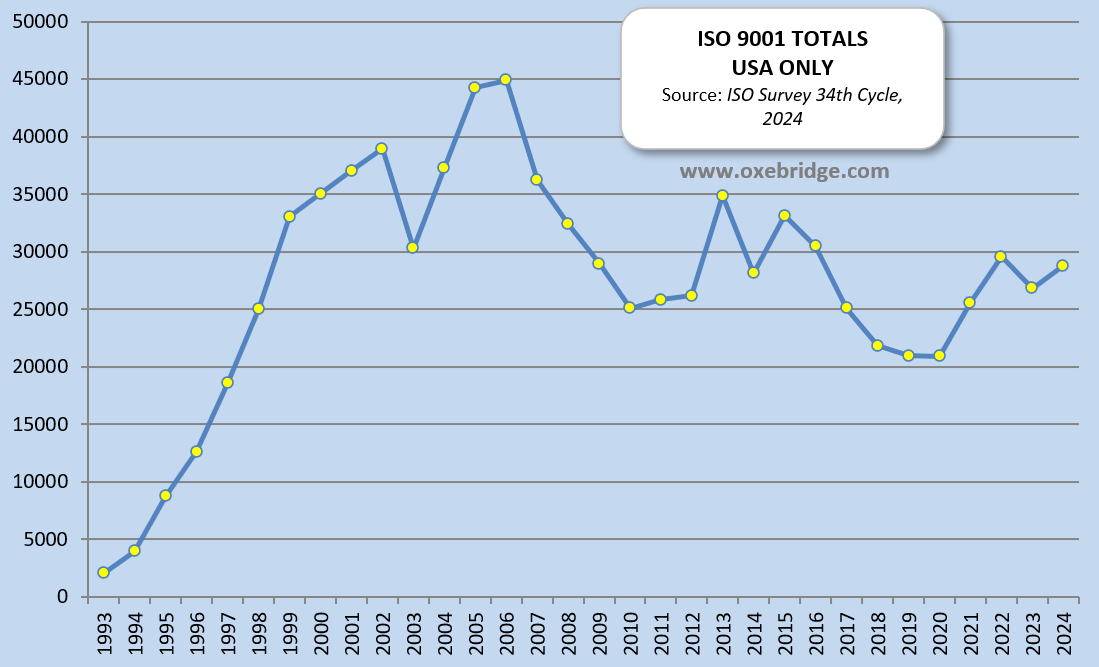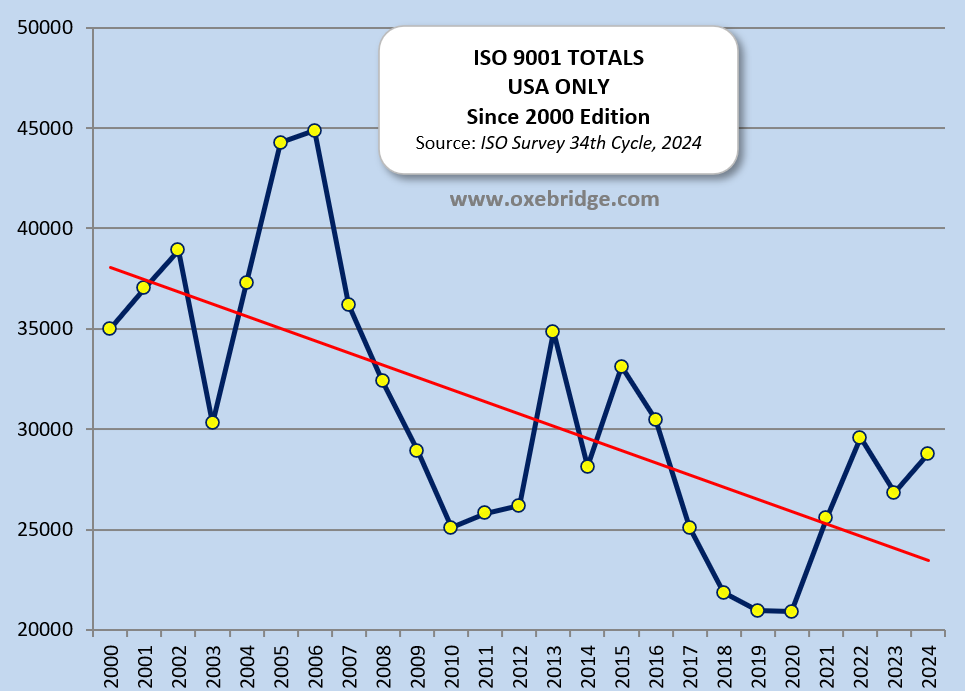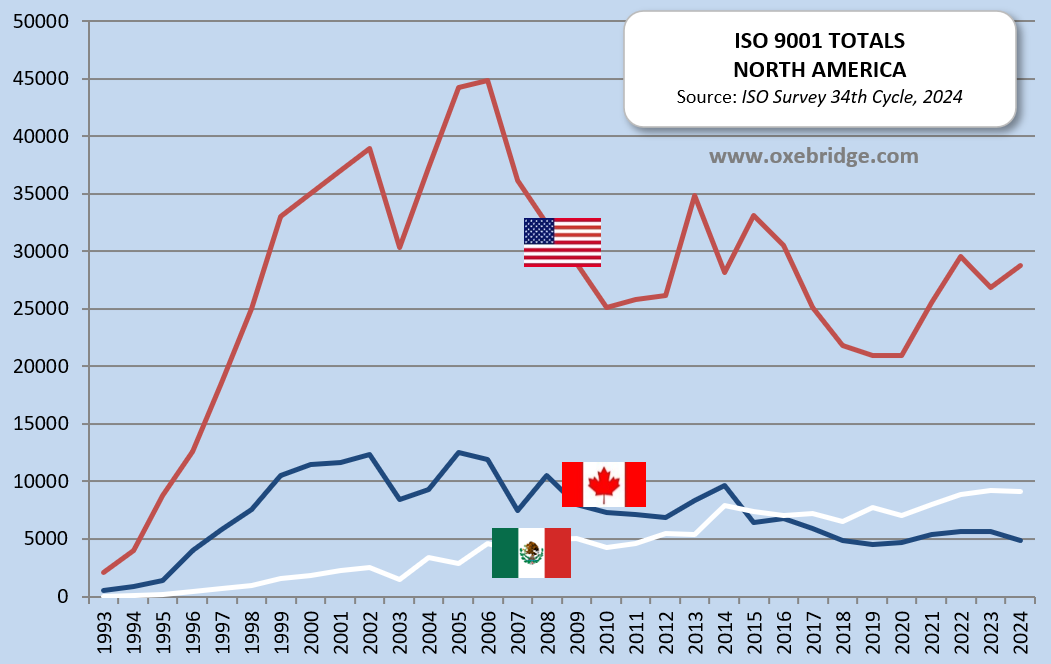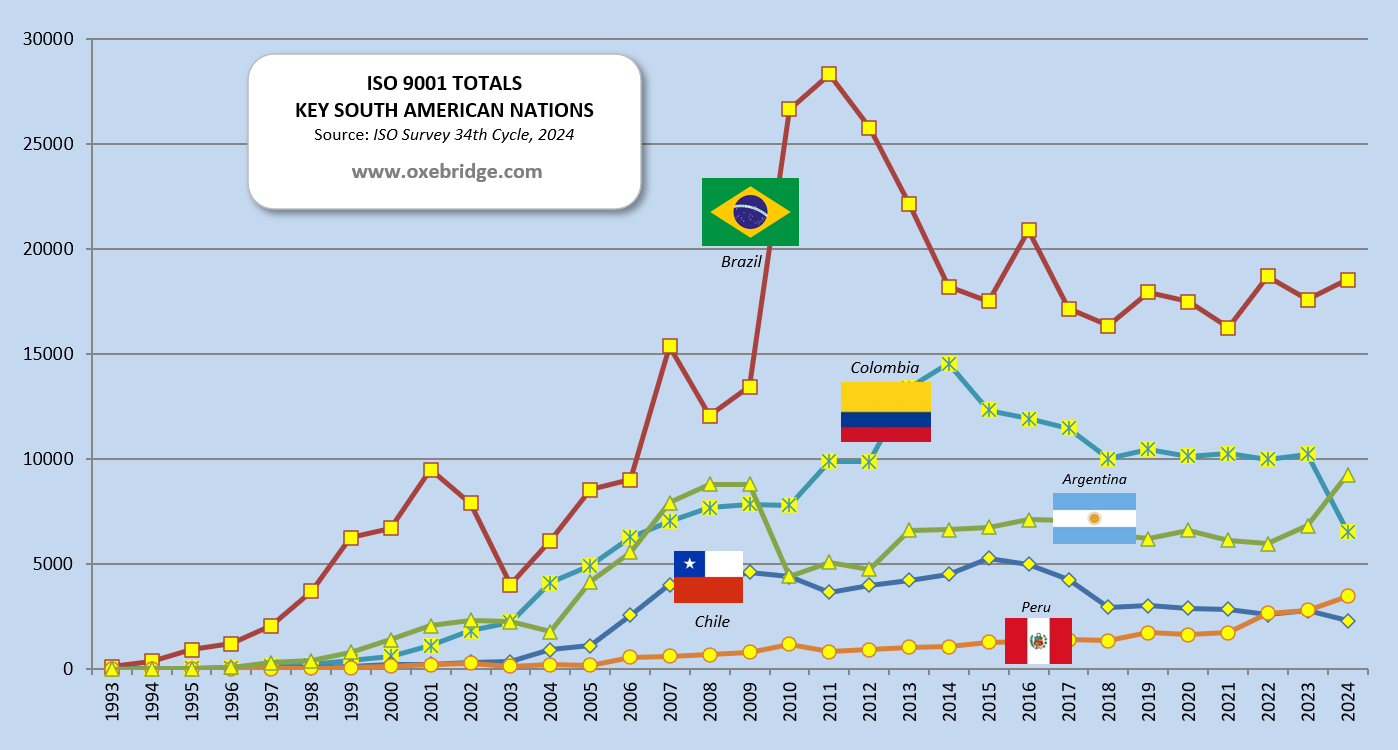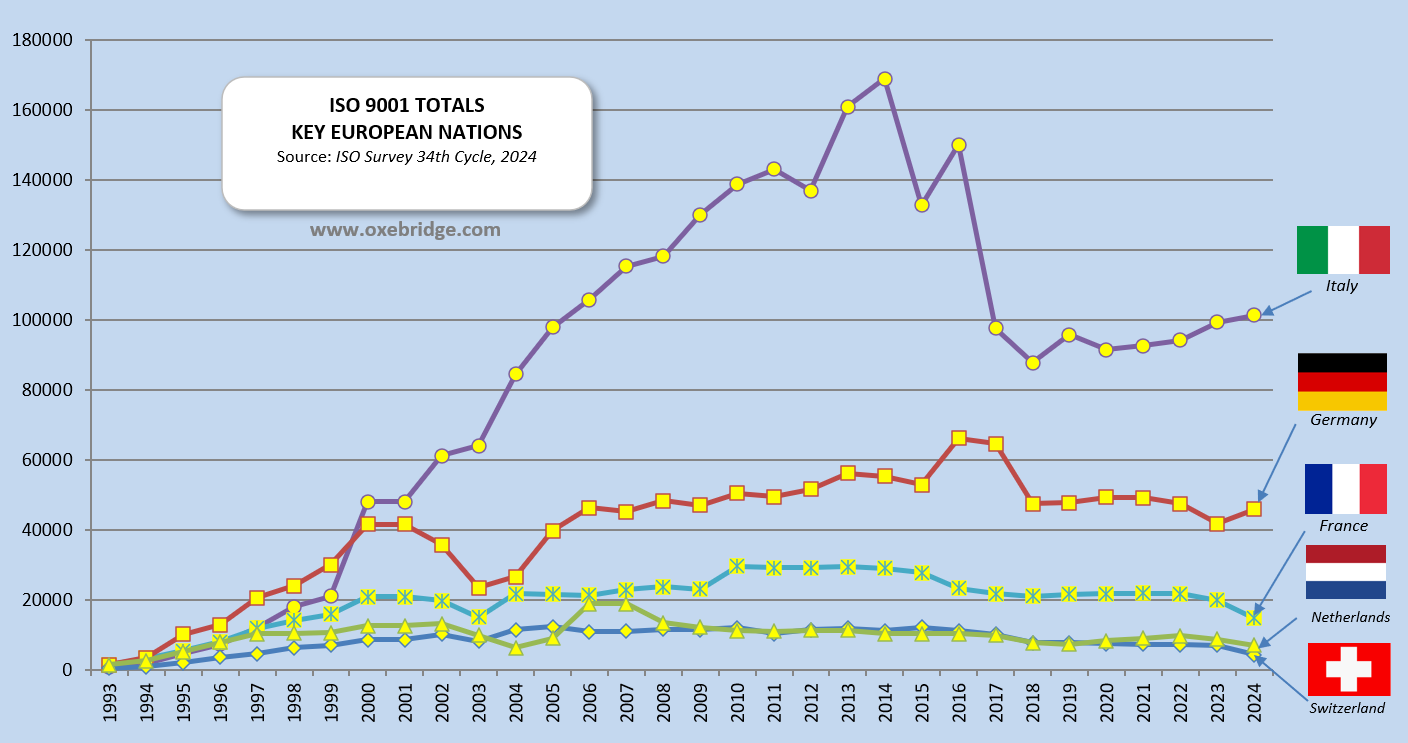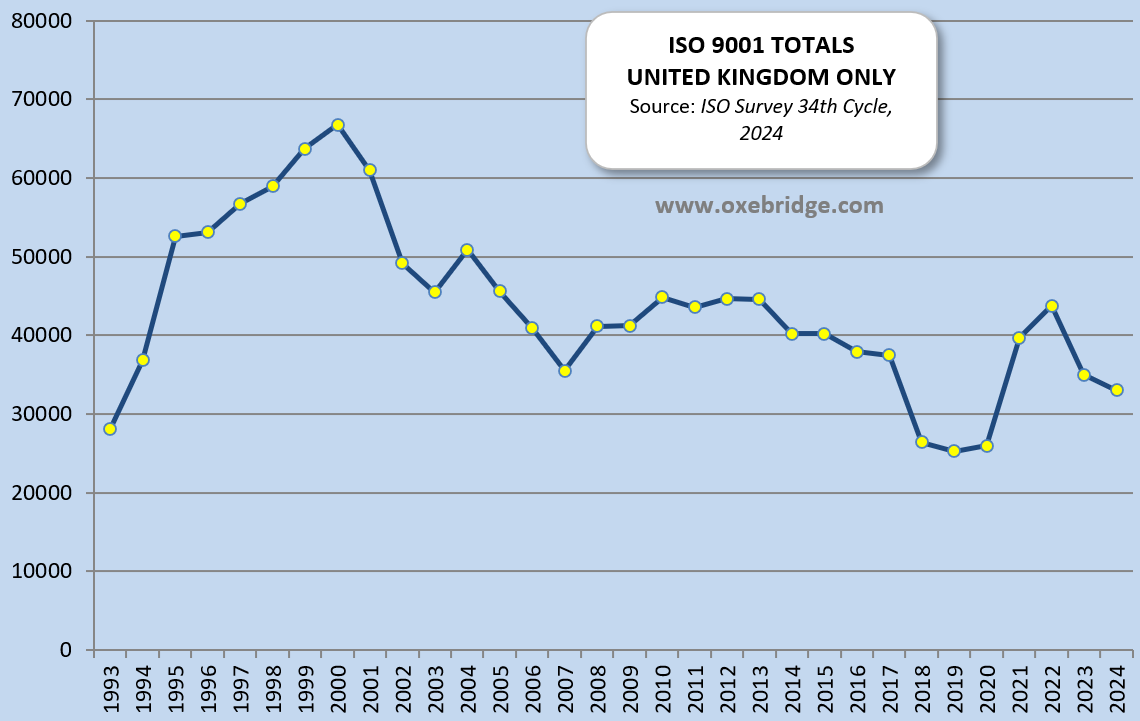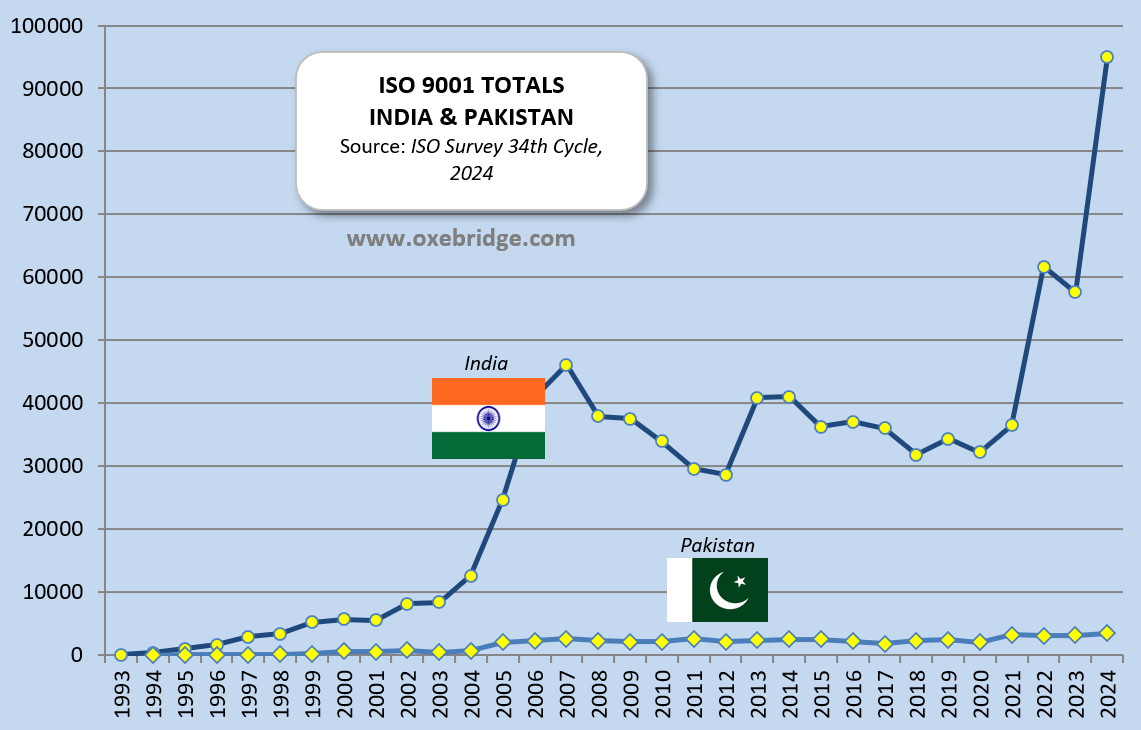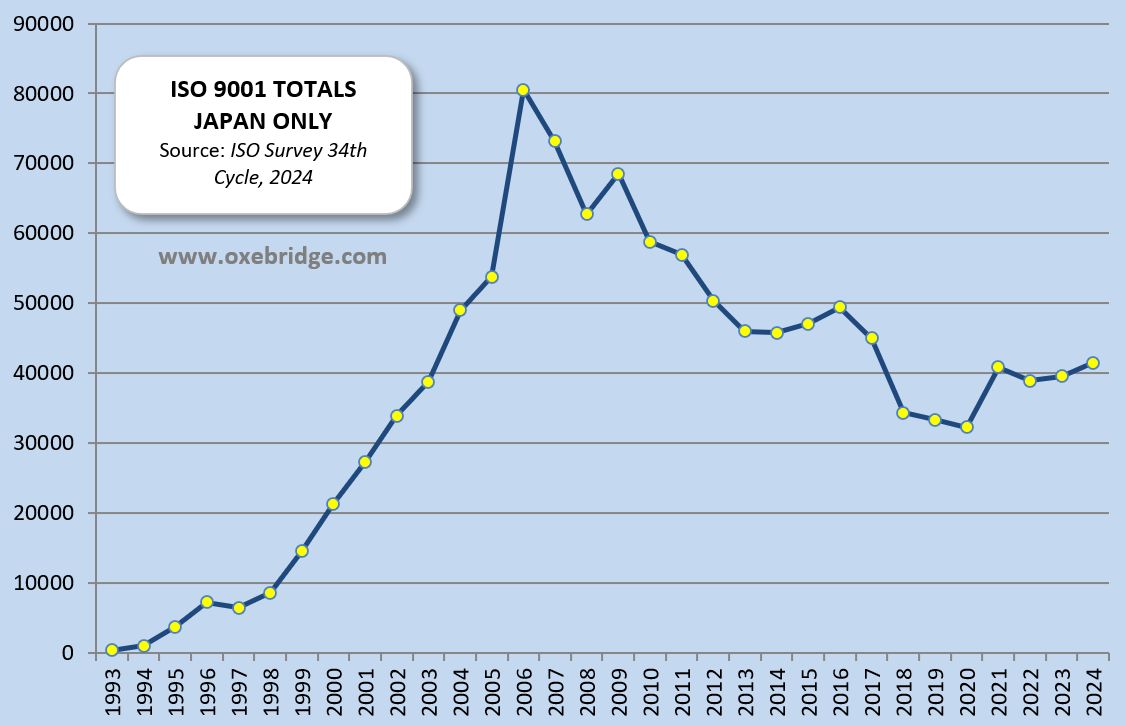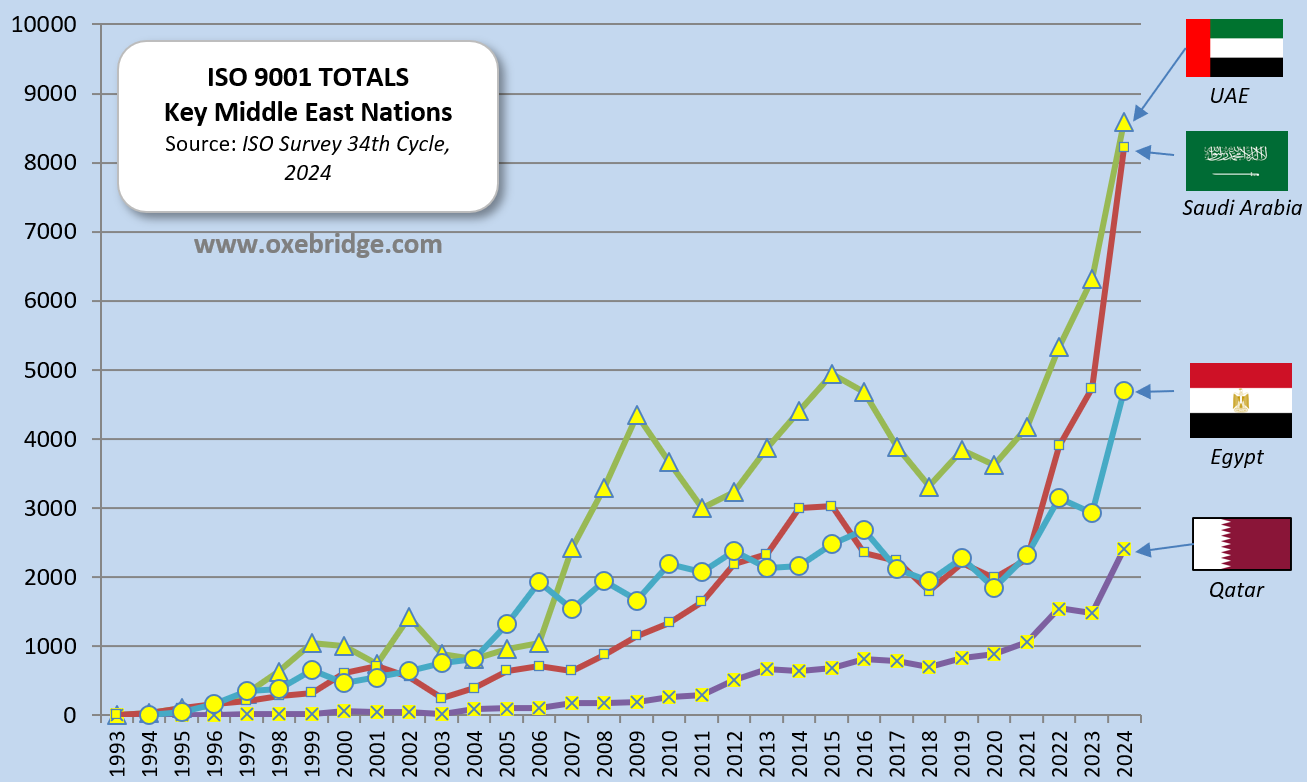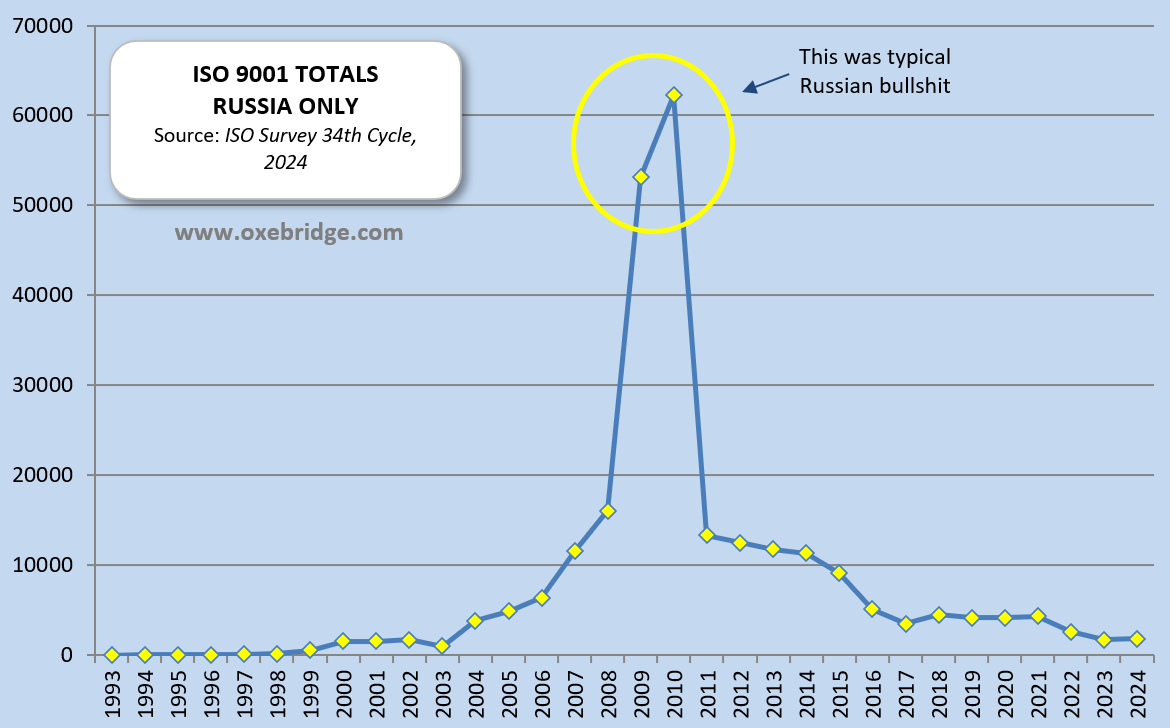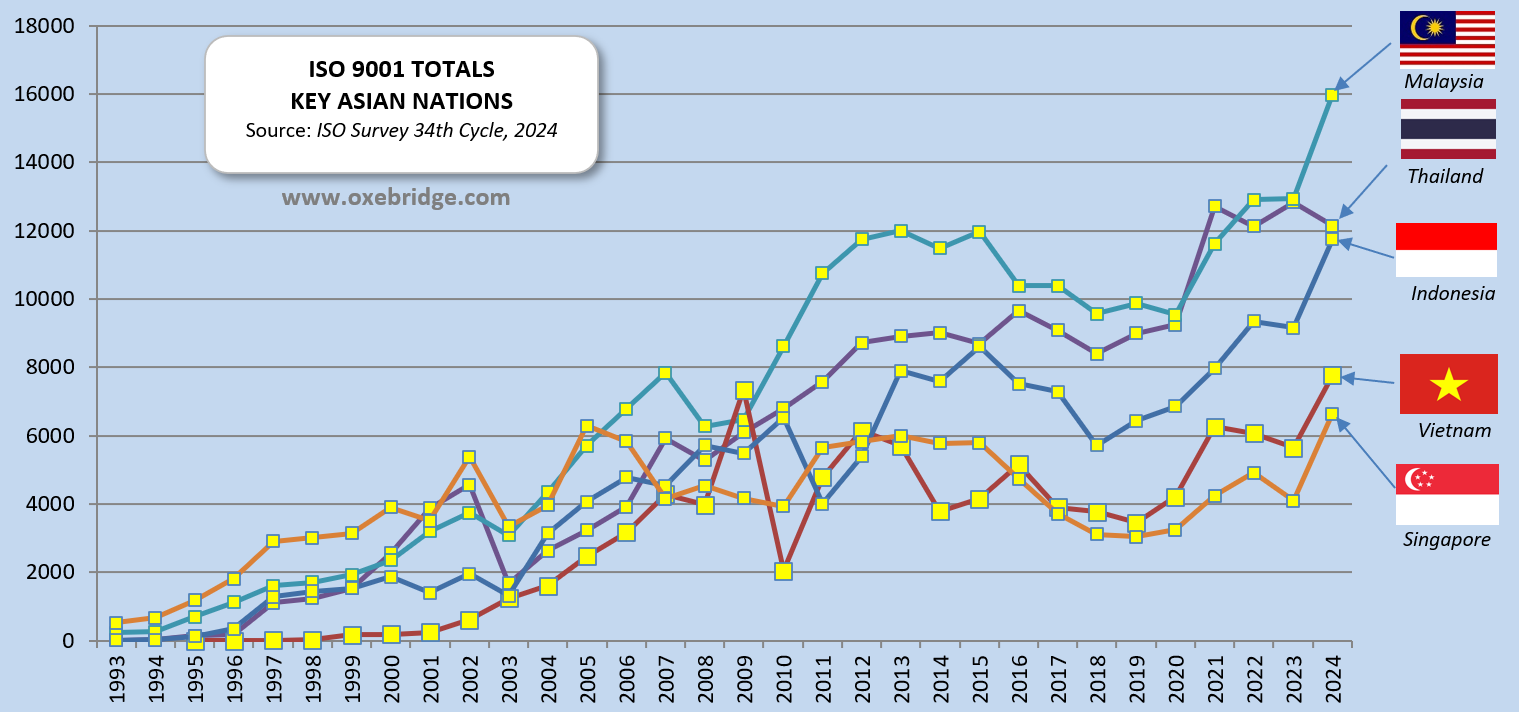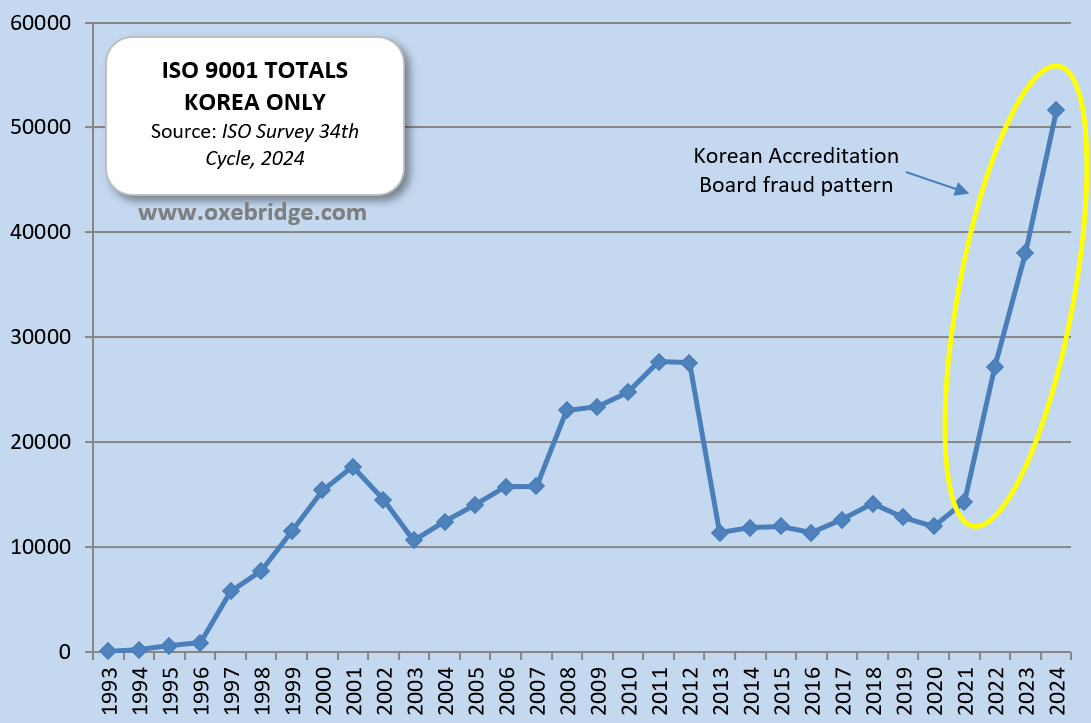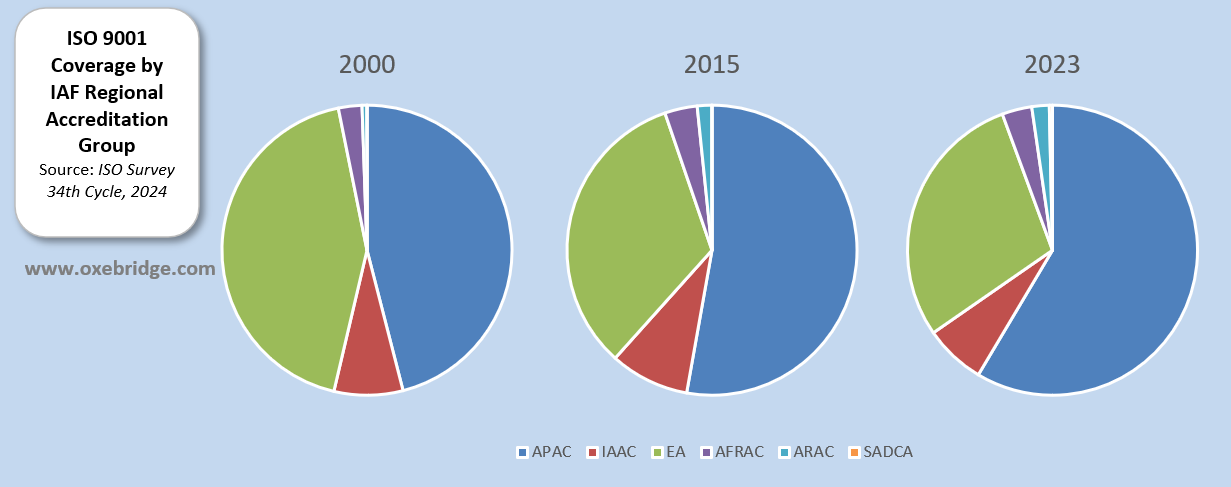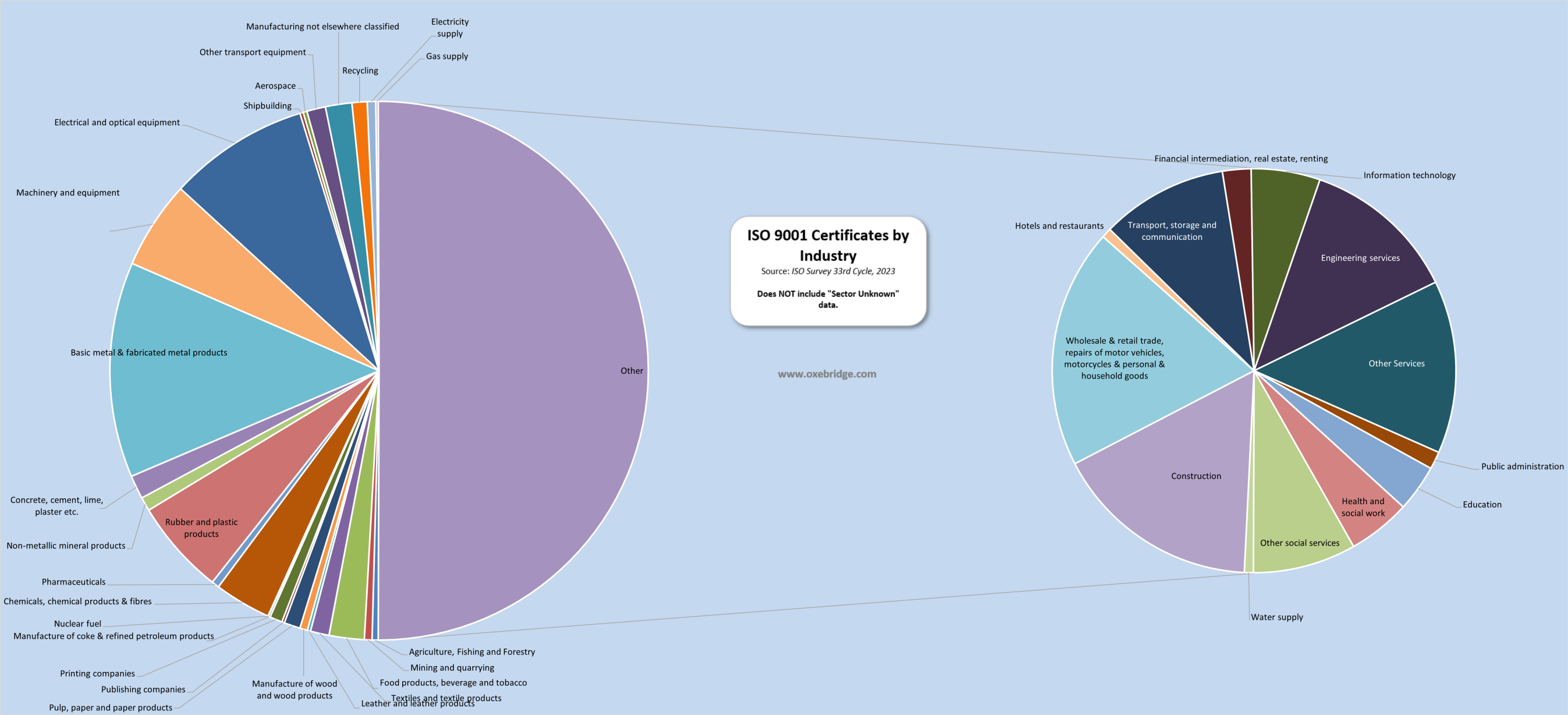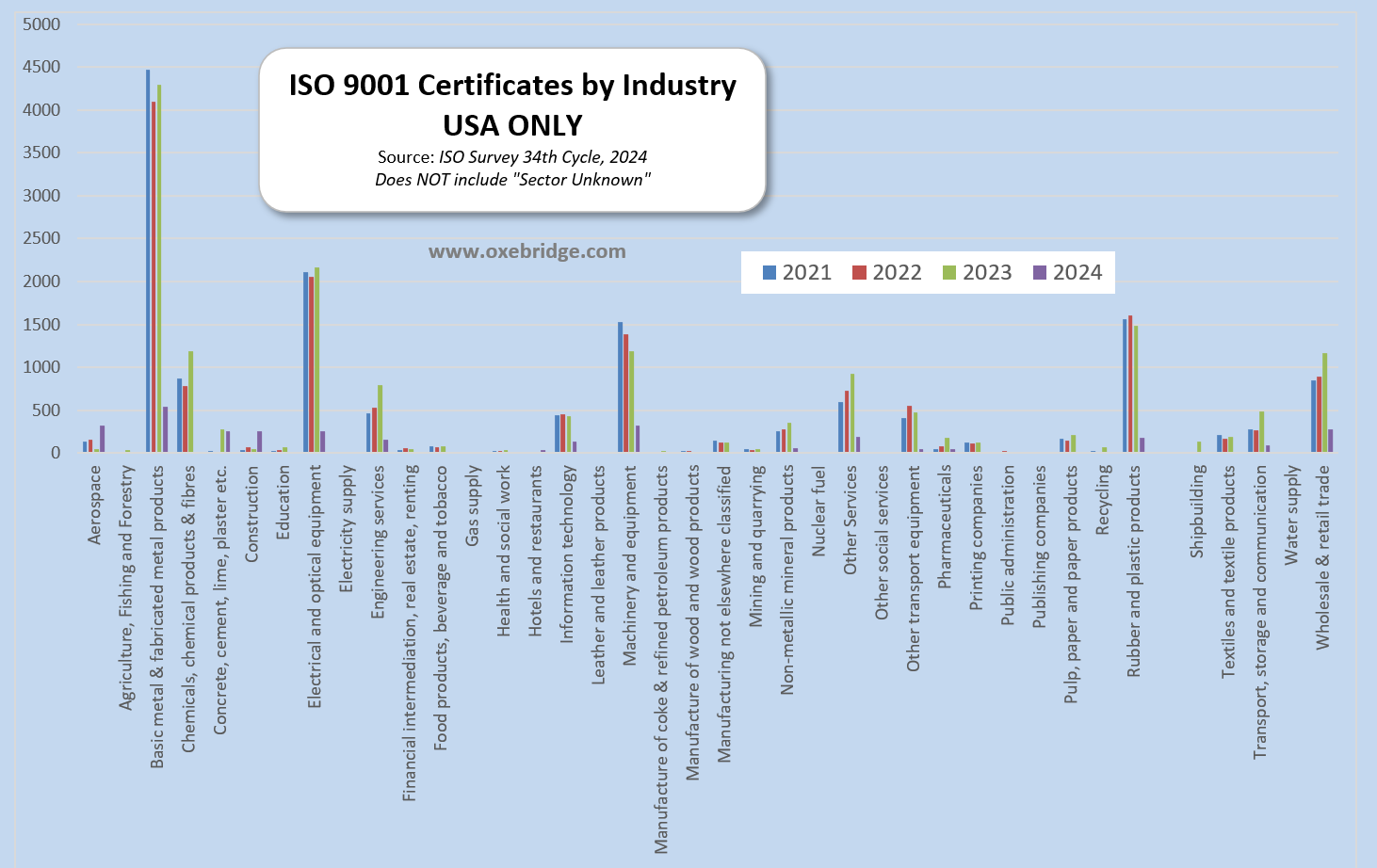ISO has released its 34th annual ISO Survey, providing data on total certificates worldwide for ISO 9001, ISO 14001, and other standards. The latest report includes data as of 2024. Every year, since 2002, Oxebridge follows up with its analysis of the data, using its own database comprised of ISO Survey data going back to 1993.
Downloads
This year, we are offering two downloads if you want to analyze the data yourself.
- ISO Survey 2024. (ZIP file, 662 KB). This is the ISO Survey itself. Users around the world are reporting that the IAF has paywalled the annual survey. This is because the IAF website will launch a pop-up asking you to buy a subscription when you attempt the download. For me, the download went through, and I just cancelled out of the pop-up, but other users are saying the pop-up cannot be circumvented. The pop-up is misleading — you do not need to pay IAF anything for the survey, but their pop-up code is causing the problems. The ISO Survey is public information, intended for public review.
- Oxebridge Full Data Set. (ZIP file, single Excel sheet, 54 KB). This is a single spreadsheet of ISO Survey data going back to 1993 for all countries. It only includes ISO 9001. This is raw data, no charts or analysis, and does not include some of the year-t0-year adjustments we make to compensate for ISO and IAF misreporting. Sometimes, ISO changes the prior year’s data (without explanation), and this would not include those adjustments. This presents the data as it was reported each year when the ISO Survey was published. It’s about as accurate as we can get.
Also, if you rely on Oxebridge’s annual analysis of the ISO Survey or just like the content here, be sure to follow me on LinkedIn, and jump onto our Discord channel for real-time chat. Also, don’t forget to go grab my Dr. Cuba crime horror novels!
TL;DR Takeaways
The “too long; didn’t read” takeaway points from this year’s survey are as follows:
- ISO now reports a total of 1,479,165 ISO 9001 certificates.
- China has re-entered the chat, after not providing any data last year and tanking the entire world’s totals. This year, they come back with numbers that defy all logic but may not be as fake as we once assumed.
- India has also spiked with impossibly high figures, suggesting the scammer culture of that country has reached epidemic proportions in the ISO 9001 world. Similar trends are seen in countries where certifications are accredited by two problematic IAF member ABs: Korea’s KAB and Egypt’s EGAC.
- Europe and the Americas have largely grown tepid on ISO 9001.
- A lack of data on sectors with ISO 9001 certificates makes this year’s analysis of sector reporting impossible. The IAF has not done a good job of enforcing the mandate for ABs to provide complete and accurate data.
- The Pope nabbed a few ISO certificates!
One note: ISO reports on both total “certificates” and total “sites“. Oxebridge ignores the site data and focuses only on certificates.
History
The ISO Survey was originally launched in 1990 as The Mobil Survey, published by Mobil Oil Co. ISO took over the reporting in 1996, and has published the Survey ever since. Initially, the surveys were labeled as “cycles,” a naming convention that ISO dropped, but which Oxebridge maintains for nostalgia and consistency. The 2024 data represents the 34th Cycle by that naming system.
As mentioned, since 2002, Oxebridge has released a corresponding “ISO Survey Analysis” report, which tries to look past ISO’s generic (and often misleading) press release blurbs to see the real trends behind the data. While ISO has changed its reporting methods over the years — in 2018, for example, ISO stopped reporting prior years’ data entirely — Oxebridge has been carefully collecting the data since 1993, and then merges the data so that it remains consistent. That allows us to have more accurate trend reporting over the full period from 1993 to the present.
The year-to-year trending was further harmed a few years ago, as ISO attempted to get IAF to take over the trending. IAF was unable to get ABs and CBs to submit data, so the numbers began to get skewed. Now, this year, the year-to-year data is once again corrupted with the final IAF takeover. This Oxebridge report tries to to show long-term trends — over decades — in order to smooth out these inconsistencies.
IAF Takes Over
This year, ISO has fully offloaded all data capture and reporting to the International Accreditation Forum (IAF). The IAF is supposed to act as the official body that oversees accreditation bodies, which then accredit certification bodies that issue ISO 9001 certificates. In recent years, IAF made participation in its CertSearch database a “mandatory” part of accreditation, forcing its member ABs to submit data on certificates issued. The rollout of CertSearch has been problematic, and the data is still wildly inaccurate.
Nevertheless, for the 34th Cycle ISO Survey, the data is now entirely provided by IAF. This has caused some additional inconsistencies in the year-to-year data.
Because Oxebridge has the data going back to 1993, the annual Oxebridge follow-up report on the ISO Survey tends to provide a far better historical picture than the annual snapshots provided by ISO and, now, IAF.
If you think the CertSearch data is accurate, you may want to read this official statement that appears on the IAF site’s Terms and Conditions page. This contradicts all the marketing by IAF, which insists the data is the sole source of truth for ISO certification data, meaning IAF openly engages in false marketing.

World Outlook
ISO now reports a total of 1,479,165 ISO 9001 certificates. This is up a whopping 76.7% over the prior year, which had a total of 837,049 certificates.
Last year’s report was an outlier, however, since China had not contributed data. That resulted in an artificial loss of tens of thousands of certificates for the 2023 data. If we ignore that year entirely and compare 2022 to 2024, the year-to-year growth is just over 50%.
The massive leaps are nearly entirely due to China and then, secondarily, India.
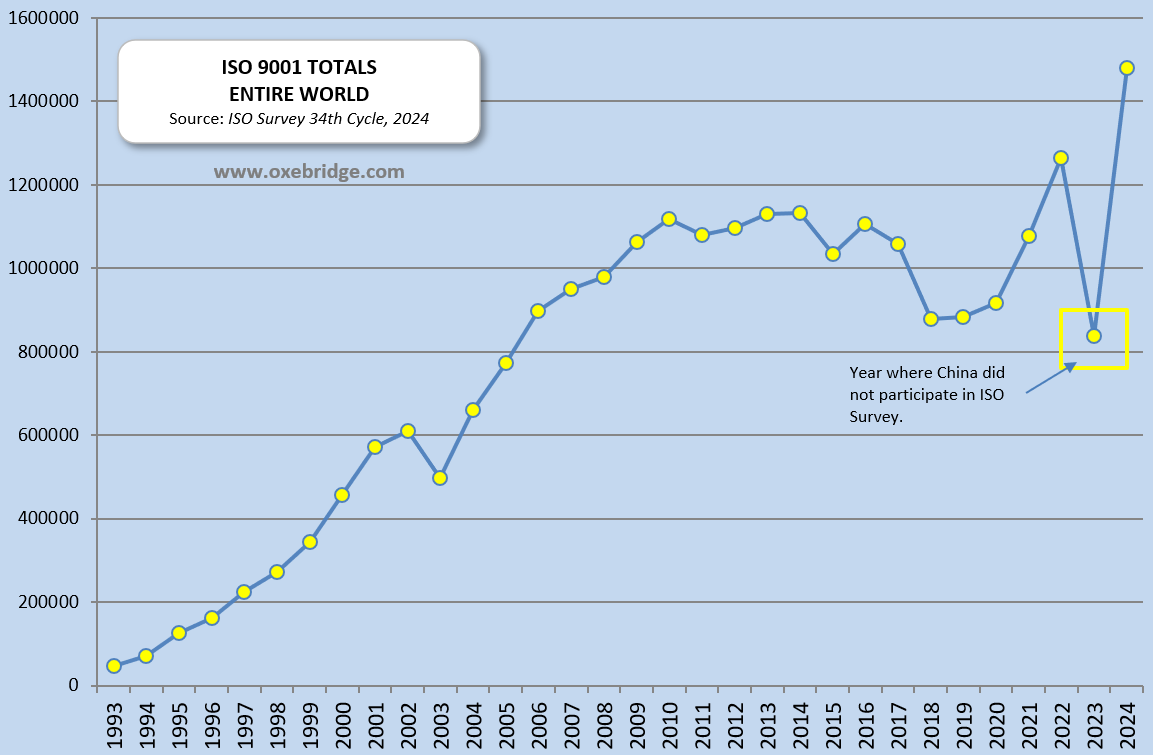
Here is what the year-to-year changes look like (click to enlarge):
China
As is evident in the next chart, the success of ISO 9001 is nearly entirely due to insanely high adoption rates in China. This chart compares year-to-year data including China (the top line) and filtering out China (the bottom line.) That red space you see is entirely China’s volume of ISO 9001 certificates.
Without China, ISO 9001 would still be relatively flat at a number far below 1,000,000 certificates, nearly flatlined since 2003 or so.
In the meantime, here is what the China numbers look like, to date:
So what’s going on China? I spent the last year trying to wrap my head around this by talking directly with people in that country. Thanks to new platforms like
Xiaohongshu (Rednote, essentially the Chinese version of TikTok), WeChat, and other Chinese social media outlets, the picture only got muddier, not clearer. I also have a lot of interaction with Chinese here in Peru, where they are moving into the country (and investing) in droves.
In the US and the “West,” we are absolutely brainwashed about China. I include myself in that diagnosis. When I was able to speak to actual Chinese and ask them unfiltered questions about both life in that country and its business practices, I was shocked to get a wide array of answers. The myth that Chinese citizens are like those in North Korea, and will be shot on sight if they say anything negative about their country, is just that: a myth. It’s not remotely true.
Mind you, the folks I am talking to come from all walks of Chinese society: the lower class, the middle class, and even the wealthier world-traveling Chinese.
I will write another article on my evolving take on China, but the short version is this: a large portion of the ISO certificates coming out of that country may well be valid. In speaking with Chinese ISO experts, I heard the following accounts:
- Some of the certificates are fake, but only in the sense that auditors are not competent and do lazy audits. Certificates are not granted without a CB actually doing an audit. It’s just that the audit they do may not be particularly robust.
- There is little in the way of Indian style “cash-for-certs” scams, where bribery runs the scheme. Everyone I spoke to agreed that’s not happening in China because the punishment is so severe if you get caught.
- Some of the growth is due to President Xi’s push to modernize the country. This has led to an explosion of high-quality manufacturing that eclipses what we saw in Japan in the 70s through the 90s.
- The population of China is so massive, anyone from outside struggles to understand the numbers because they really do have that many companies in operation.
For now, I will leave it at that. But the issue of China’s massive uptake in ISO certificates may not be the fraud I previously assumed it was.
There was a slight uptick in certificates in the US, but only barely. The numbers are still stuck at an invisible wall that won’t get above 30,000. This is far from the US’ peak of nearly 45,000 certificates in 2006.
Much of this can be laid at the feet of ISO’s insistence to tinker with the popular ISO 9001:2000 version; prior to that tinkering, ISO 9001 certificates were flying off the shelves. The next chart shows the US trend since the 2000 version of ISO 9001, ignoring previous years. The trendline is calculated by Excel.
North America
Comparing the US to its North American neighbors, the data appears as follows:
Canada continues to decline and is slowly being eclipsed by Mexico.
South America
Looking at some key South American bellwether nations, here is what we see:
Brazil continues to dominate. Colombia has plummeted to such a degree that I think their AB (ONAC) might have screwed up their data; expect to see a correction next year. We do see Chile and Peru — sworn enemies on the national stage — flip places this year, with Peru finally claiming more certs than its neighbor.
European Bellwethers
Every year, we report on a few key European nations to gauge how things are going on the continent where ISO 9001 was born; these are Italy, Germany, France, and ISO’s home country of Switzerland. The chart below shows this data, and I’ve added the Netherlands this year, since they have such an outsized influence on the actual text of ISO 9001 revisions.
I used to report on Belarus in this section, just because they were claiming so many fake certificates. That seems to have been corrected — is IAF CertSearch working? — so it’s not worth making my annual jokes about Belarus, and I removed them.
We see three of the key nations — France, the Netherlands, and Switzerland — all declining in their ISO certs.
Italy continues to be Europe’s darling ISO 9001 adopter, but they are still nowhere near its heyday of the 2010s. They have essentially flatlined.
As I’ve said in prior years, the overall picture is that Europe — once the home of ISO 9001 — has most definitely lost its interest in the standard.
United Kingdom
For the UK, we saw a ridiculous spike over the past few years that didn’t make much sense. The ISO gods claimed this was due to improved reporting through the UKAS CertSearch database. Now it’s looking like those spikes were false, and the figures have normalized.
India & Pakistan
In 2022, we saw India embrace fraud and start reporting what are absolutely fake numbers. There was a slight dip in 2023, but the Indian scammers are back at it.
This year is no different, but we see a very tiny dip. The total (57,658) is likely polluted by half, which I suspect are fake certificates issued under full IAF-member accreditation marks. India gave up giving a shit about its reputation in the world, and so lies and lies and lies.
Whereas in 2023, India claimed to have 57,658 ISO 9001 certificates, it now reports 95,007. That’s a 39% jump in only one year. There is no way anyone believes those certificates are real. They may well be issued by IAF-accredited bodies, but those bodies — including the tax scammers United Accreditation Forum (UAF) — are flooding the market with fake, rubber-stamped certificates that are exchanged for cash. No audits, just dump some money in an account, and you get certified in India. The government could do something about it, but the government is corrupt itself, so don’t expect any cavalry to come.
I like comparing India to its more sober pal, Pakistan, which, you see, has more realistic growth rates. It also pisses India off to be compared to Pakistan, so I do it every chance I get.
Hey, India, if you don’t like people making jokes about your country, maybe fix that scammer culture.
Japan
Japan’s numbers have flatlined. It’s something to notice, too, as China’s worldwide quality improves and Japan’s is now deteriorating under cultures of white collar fraud that pollute their industries.
Middle Eastern Bellwethers
I like tracking key Middle Eastern countries, since so much of the fraud facing the ISO scheme comes from those nations. Here we track major abusers of ethics and peddlers of fraudulent certificates: UAE, Saudi Arabia, Qatar, and Egypt. The numbers this year are as impossible as you’d think.
So much of this falls on another of the world’s scammers, the Egyptian accreditation body EGAC. That body has adopted the UAF practices of rubber-stamping any certification body that pays it money. EGAC-accredited CBs then issue fake certificates in bulk, resulting in the numbers you see above.
For Saudi Arabia, it’s not just EGAC, but a number of other ABs that have surrendered to the lure of Saudi bribes. We filed major complaints against the German accreditation body DAkkS for blessing some corrupt Saudi operations, but DAkkS refused to take action. Saudi money is too good to turn down.
Russia
Russia is still a shithole, to the surprise of no one except Putin.
The Asian Bellwethers
For this region, I selected Malaysia, Thailand, Indonesia, Vietnam, and Singapore to track. Many of these are accredited by another IAF scammer member, the Korean Accreditation Board (KAB). Like UAF and EGAC, KAB allows anyone to become accredited and then flood the market with fake certificates, all bearing the IAF logo. Here we see all the nations tracked, except for Thailand, displaying suspicious spikes over the last year.
South Korea
I started reporting on South Korea separately in 2023, after I noticed the numbers coming out of that country made no sense. Over the last two years, I’ve tracked that down to fraud at that country’s accreditation body, KAB, which is flooding the world with fake certs. Now, certificate mills in other continents know they can get accredited by KAB because the AB won’t do any actual audits of their operations. The problem hits Korea itself especially hard:
I am sure that if I checked, I would find some new executive took over KAB right around 2020 or so, which is when the numbers coming out of that country grew to implausible levels.
The Pope and the Palestinians
For the first time ever, the Holy See — yeah, the Vatican — has some ISO certificates on the board. Two, in fact.
Meanwhile, ISO thumbed its nose at Israel and the US, and started reporting data for “The State of Palestine.” If I recall, it had not used that phrase in prior reports. Palestine has 66 certificates.
IAF Regional Body Analysis
For the first time, I ran a quick analysis of the data but with a focus on the likely IAF Regional Accreditation Groups applicable to each country. This isn’t hard data, since I have to guess which of the six IAF RAGs are most likely to operate in a given country, but it is likely close. The six RAGs are:
- APAC (Australia, New Zealand, Asia, and Asia Pacific, but basically accredits anyone)
- IAAC (Americas)
- EA (Europe)
- AFRAC (Africa)
- ARAC (Middle East, but mostly Saudi Arabia; APAC does the rest of the region)
- SADCA (South Africa)
I wanted to test a theory: that Graeme Drake over at APAC had been gobbling up market share due to his tolerance for allowing any fly-by-night scammer to join the IAF under APAC’s banner. So, the following chart shows the breakdown of IAF RAGs over three annual reports (2000, 2015, and 2023). As you can see, APAC is now the major IAF regional body, with its members issuing the most certificates and, thus, generating the most money for ISO and IAF. That is why Drake is protected by them.
To be honest, though, I thought the numbers would be much, much higher for APAC.
ISO and IAF still can’t measure sectors properly. This has been an ongoing joke for decades, and I’m not sure why it presents such a problem. For a while, they stopped reporting on this entirely. Then they fell back into it, and I thought they finally had consistent data again, and I reported it as such last year.
This year, however, the data is entirely useless. Despite a formal accreditation mandate requiring CBs to report on sectors and then include that in the CertSearch data, the IAF member ABs are not enforcing the rule. Now, the overwhelming majority of certificates are issued without any sector indicated at all. That’s a huge violation, but the IAF clearly can’t be bothered to care.
Here is what last year’s data looked like:
And this is what we have this year. I didn’t even bother to finish the graphic because it’s so useless.
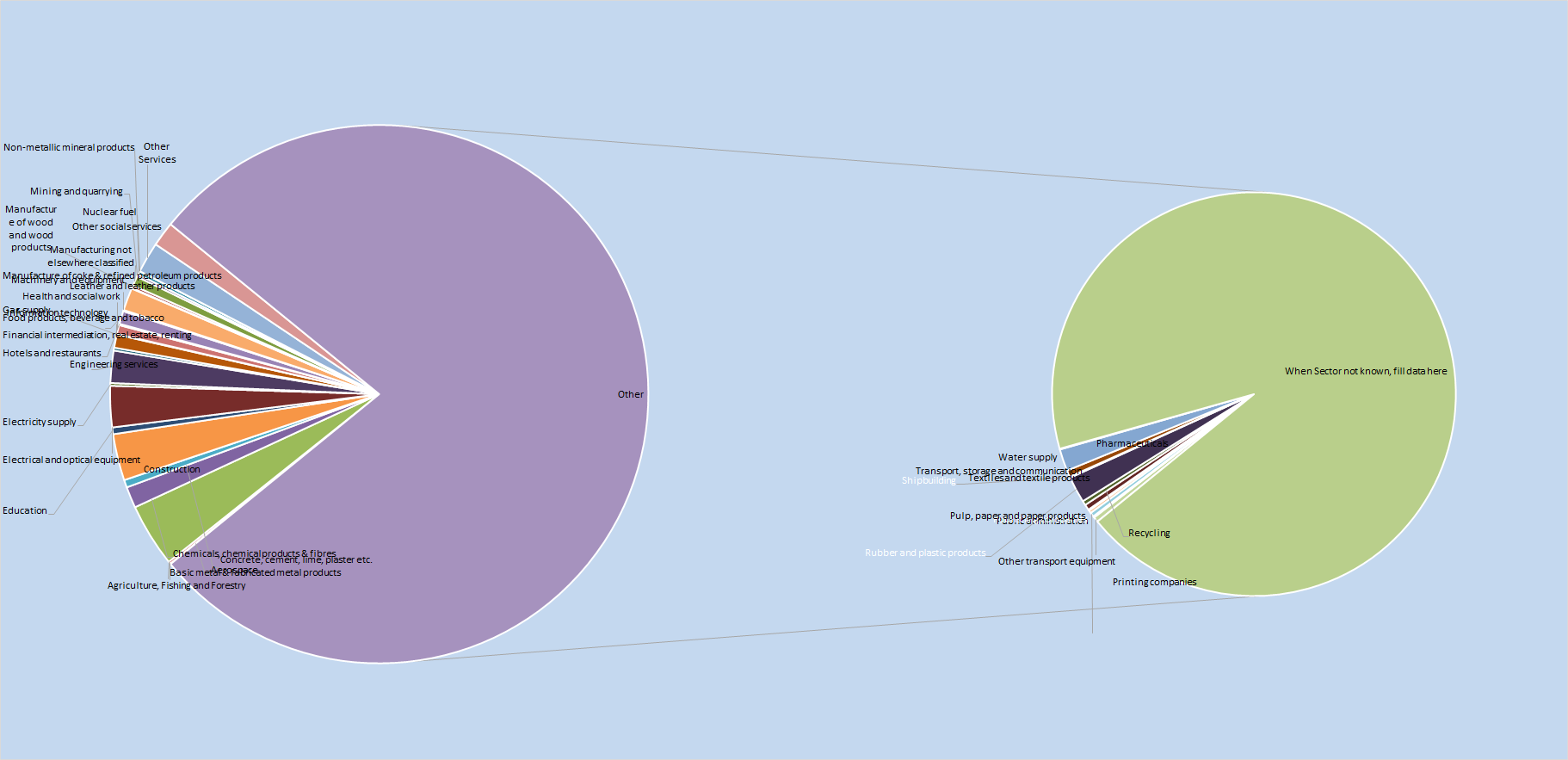
In studying just the sector trends in the USA, we see the following. I’ve added four years to this table, so you can see minor trends within industries year-over-year.
Winners and Losers
The top ten nations with the most certificates as of 2024 break down as follows:
- China – 651,851 certificates
- Italy – 101,426 certificates
- India – 95,007 certificates
- South Korea – 51,657 certificates
- Germany – 45,983 certificates
- Spain – 41,616 certificates
- Japan – 41,525 certificates
- UK – 32,988 certificates
- USA – 28,783 certificates
- Brazil – 18,536 certificates
These are nearly the same countries as last year, with Korea leapfrogging over Germany and Japan. Brazil nudged France off the list entirely.
The top ten losers — representing the countries that lost the most certificates — are as follows:
- Belarus – lost 6020 certificates (couldn’t keep up the fakery, I guess?)
- France – lost 5221 certificates (mon dieu!)
- Colombia – lost 3685 certificates (filing error at ONAC, I bet)
- Switzerland – lost 2692 certificates (did the Mafia stop buying ISO certs?)
- Israel – lost 2600 certificates (hard to maintain audits during genocide operations)
- United Kingdom – lost 1968 certificates (I blame the loss of Harry)
- Romania – lost 1740 certificates (did anyone notice they were missing?)
- Netherlands – lost 1693 certificates (even the Dutch are sick of Dick Hortensius)
- Croatia – lost 1414 certificates (probably due to Russian invasion)
- Finland – lost 887 certificates (I have no jokes for the Finns)
Summary
There are two ways to think about this data.
- Postulate # 1: ISO 9001 is popular, and it’s a coincidence that it’s more popular in countries with poor accreditation oversight.
- Postulate # 2: The IAF has abandoned all pretense of enforcing ISO 17011 on its member ABs, and now everyone is rubber-stamping everything with an ISO 9001 logo.
I’m of the latter camp because I believe the facts point to this unfortunate situation. Victor Gandy at IAF has surrendered all attempts to even make it look like he wants to do his job. Instead, the IAF has embraced fraud and scams because it makes money from scammers like UAF, KAB, and EGAC. Corruption rules the scheme, and the evidence appears overt and plain as day.
As for China, well, I spoke about that above and do plan to have a few more articles on Quality Management in China. The situation there is more complex than I had assumed.
Here are a few of the prior Oxebridge analyses of previous ISO Surveys:
- Oxebridge Analysis of ISO Survey 2018: Facing 20% Loss of ISO 9001 Certs Worldwide, ISO Dismantles Data Trending
- Oxebridge Analysis of ISO Survey 2019: Bleeding is Slowing, But Patient is on Life Support
- Oxebridge Analysis of ISO Survey 2020: China to the Rescue
- Oxebridge Analysis of ISO Survey 2021: China, UKAS Corrupt the Data
- Oxebridge Analysis of ISO Survey 2022: IAF CertSearch Gunks Up the Works
- Oxebridge Analysis of ISO Survey 2023: China Has Left the Chat
Christopher Paris is the founder and VP Operations of Oxebridge. He has over 35 years’ experience implementing ISO 9001 and AS9100 systems, and helps establish certification and accreditation bodies with the ISO 17000 series. He is a vocal advocate for the development and use of standards from the point of view of actual users. He is the writer and artist of THE AUDITOR comic strip, and is currently writing the DR. CUBA pulp novel series. Visit www.drcuba.world

